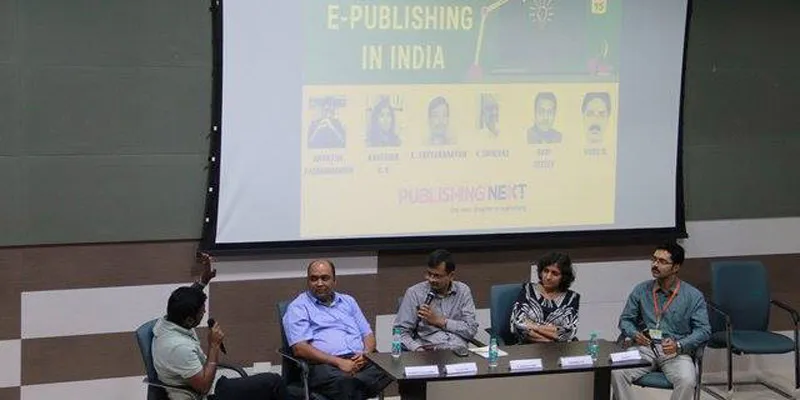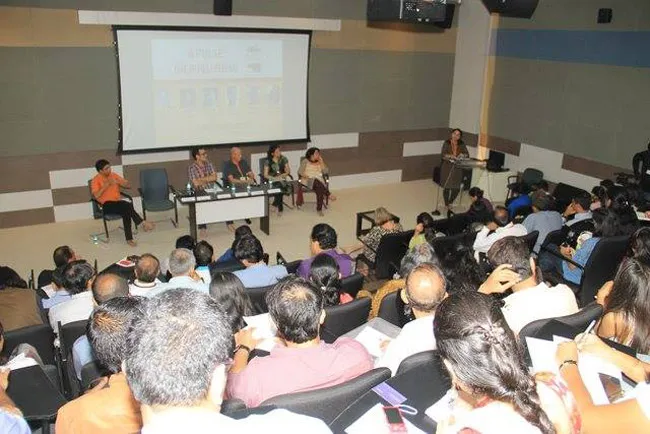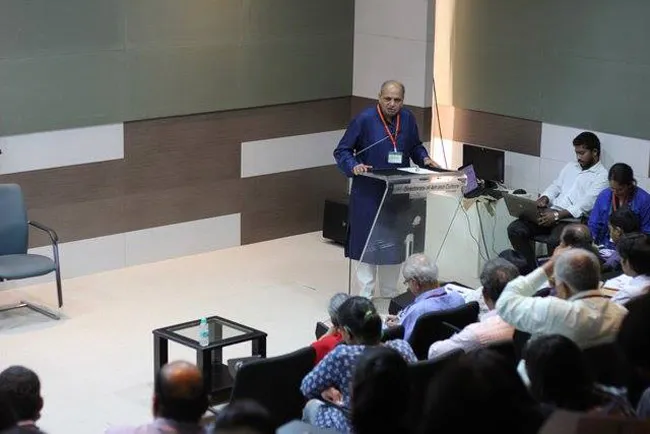Publishing Next 2014: a peek into publishing in India and how e-books fare in the Indian market
With the advent of e-books, the publishing industry has undergone a sea change. It is worthwhile to find out what drives this industry today. The fifth edition of Publishing Next, a conference on publishing in India, held at the Krishadas Sama Central Library in Goa on September 19 and 20, saw engaging debates and provided a sneak peek into the publishing scene in India.

“The barrier to entry is high in publishing,” said Naveen, Founder of a self-publishing venture Notion Press based out of Chennai, when talking to YourStory sometime back. It is because the publishing ecosystem globally seems to have its own standards. It is populated with editors of literary merit or a strong understanding of the turf in which they operate, publishers having strong opinions and wanting to bring diversity of content into the debate, and readers who are supposed to carefully choose what they read.
The economics of the trade is even more baffling. The authors, the creators of content, get as low as 10% of the book’s retail price or even less as royalty, the publisher another 30% to 50% (in which they have to include their overheads and profit margins [which could eventually be somewhere between 5% and 10%]), and the bookseller (distributor/off-line bookstore) a hefty 40% to 60%. The norm is that the publisher shares 25% with the authors of what they eventually get out of it after discounting for the distribution cost.
Self-publishing seeks to bypass editorial oversight as well as create reasonable returns for authors creating content. Online distributors seeking to cut down the distribution cost entered the market (Amazon.com worldwide, Flipkart and Infibeam in India, for example) but are being challenged by publishers for their monopolistic attitude. Publishing therefore seems to be an opaque world for an entrepreneur to enter. The heart-warming news is that there are still publishing ventures created seeking to make a difference.

E-books in the Indian market
The technology of book production has seen tectonic shifts with the invention of novel methods of offering content to the readers. The latest is e-books threatening the survival of print books, which is still consumed as much as 95% in India. The discussion at Publishing Next provided insight into how the Indian publishers are responding to the onslaught of e-books, which is expected to become the predominant form of reading in the decades to come. Major multinational publishers operating in India, like Penguin Random House and HarperCollins India, follow the same pattern of pricing. E-books are priced equal to print books. HarperCollins has experimented with 21 of its titles for offering in e-book form in an initiative called Harper21. Karthika V.K., Chief Publisher at HarperCollins India, and Anantha Padmanabhan, Vice President of marketing at Penguin Random House India, informed the audience of their several initiatives to address the growing e-book market. Most of their approach seems to be testing the market rather than aggressively taking it on. R. Vivek, Business Development Head at Flipkart, agreed with the publishers that there is no information of what kind of readers are consuming the content. This is because Flipkart has not invested in tracking reader preferences as it could not develop analytics capabilities in tune with its fast-paced growth. Pearson India, which dominates the academic school book market in India, is also treading a path of caution, as K. Srinivas of Pearson informed the audience.
But all the speakers on this panel on ‘E-publishing in India’ seemed to agree that e-books are registering a fast pace of growth, but forms only 3 to 9% of the overall sales. This seemed to be the pattern in the United States, the leading publisher and consumer of content, five years ago. At what rate the Indian market will grow is still open to debate.
Technological services
There were two presentations that caught the eye at Publishing Next. Netex, an e-learning company focused on the Spanish market, is seeking to offer “enhanced books” (a new label for e-books) with rich multimedia content in the digital format and its presentation claimed that this form of offering provides varied options for the Indian school content. It has been successful in implementing bookless content in 450 schools in Spain. This seemed far-fetched and didn’t strike a chord with the Indian publishers. ePub 2’s limited capabilities formed point of debate and publishers and service providers came to a consensus that ePub 3 with multimedia capabilities is likely to bring variety to the way content is offered.

The other presentation was by News Hunt, an aggregator of news and publishing content. It is betting big on its publishing services by expanding into the language publishing market. Recently, it has raised Rs. 100 crores from investors for its expansion primarily into digital language publishing. While English is served well by service providers, books published in Indian languages are not offered as much on digital platforms. One reason that was heard was that language publishers insist on placing the books on the pricing terms they want to dictate. These technicalities aside, Flipkart is soon going to offer Hindi books on its e-book app. Bengali books are also on the anvil, as Flipkart’s Business Development head Vivek informed the audience.
Entrepreneurial ventures in publishing
Publishers seeking to bring specialised content driven by passion entered the publishing market only to see it pan out in a different way than they expected it to be. Blaft, a publisher from Chennai, has scaled down its operations because it was unable to drive its publications into the market as fiercely as it wished. The lament I heard was that booksellers have their own preferences and do not promote novelty as expected by the publisher. But a tale of success, or perseverance if you will, is that of Aakruthi Books, a publisher based out of Bangalore. The young D.N. Guruprasad, its Founder, informed his intent of focusing on preserving Kannada literature in the last edition of Publishing Next and has been successful in turning a publisher and bookseller in a year. His bookstore has a rare collection of Kannada books and gives the option to buy from its available second-hand list for the readers.
M.S. Sridhar, Co-founder of Smart Solutions based out of Mumbai, told me that his company is starting to offer e-book conversion of books in any language to customers. They have worked out ways to overcome font issues by working on experimental set of titles. ReadMyStori, founded by Shailesh Gogate based out of Pune, is offering a platform for authors and publishers to get readers to “read, appreciate and popularize” their work. It also offers readers up to 20 free e-books written by new, upcoming and existing authors. “This encourages new authors to promote their book,” said Shailesh.
InstaScribe, an e-book conversion service in its beta version, offers to convert content in the *.rtf format (which can be created using Microsoft Word) into ePub and Mobi formats. It is an offshoot of the self-publishing venture Pothi.com, Co-founded by Abhaya Agarwal and Jaya Jha. Jaya, who was at the conference, told me, “It’s free in the beta version and we encourage users to try it and provide us feedback.” There were at least two people I know who had come to the conference with the intent of starting new publishing ventures.
Another venture that seems surprising is that of Renisha Winston who found that there exists a gap in quality journals published out of India. To serve the academic journals market, Renisha founded i-manager publications, based in Nagercoil in southern Tamil Nadu, which now publishes 30 academic journals. The surprising element is that academic journals market is a tough one dominated by a few international publishers such as Elsevier. [u1] The focus on ‘hot’ genres
It was heart-warming to see that poetry is seeing a revival as publishers have now shed their inhibitions about publishing poetry, considered a non-selling genre. The endeavour of some Hindi poets in starting Poetrywala.com, a platform which curates and publishes Hindi poetry, shows that such independent initiatives dot the publishing landscape in India and that the old guard and new crop of authors are not averse to exploring novel technological options.
Graphic novel is a new genre that is rapidly growing and finding readership in the Indian market. Children’s book market is a growing one in India, with variety and experimentation ruling the roost. Publishers are interested in new offerings while authors seem to be open to technological overlays on traditional content. The apps, the games, and the visuals-rich books are some new ways explored to reach out to the children. It would be interesting to note that although children consume content, it is the parents who make the buying decisions, although children in teens might have a say in their preferences.
The vision for publishing in India
Prof. Ganesh Devy, who deserves state honour for his phenomenal work on researching on linguistic diversity of India, provided a vision for Indian publishing in his keynote. His Linguistic Survey of India is to be published in 50 volumes by Orient Blackswan. You can imagine the enormity of effort that has gone into his research. Prof. Devy was an English professor who saw the death of many languages in India. An estimated 600 to 800 languages exist at present in India, but eventually only 300 of them will survive. Do we have a scent of it? He said colonization by the British all over the world gave the tribal people in their countries a new label—indigenous people. “Do indigenous people exist in England?” he asked. The new label meant a new identity to these people as the ‘Other’ and their culture thrown to oblivion. But they have a very rich and diversified culture that has gone unrecorded. He also said that the concept of nation-state provides a narrow identity of citizenship whereas humans have been nomads by nature. Nomadic culture that exists is not paid attention by publishers. “Eight out of 100 people in the Himalayas have published their own books,” he declared, calling this phenomenon “publishing selfie.”
He went on to call the publishers to create a rich coastal literature as the nation boasts of a 4,500-kilometre-long coastline and no literature exists on it. Will the publishers, existing and new ones, pay heed?
Publishing Next is proving to be an engagement and debating platform for not only publishers, authors, and booksellers but also for others interested in the publishing scene in India. Karthika V.K. of HarperCollins India rightly said that Publishing Next provides an opportunity for publishers to look at themselves.
Kudos to Leonard Fernandes and Queenie Rodriguez, the Co-founders of Cinnamon Teal, a self-publishing company in Goa, for creating this conference and running it successfully for five editions, and to the advisory team consisting of an independent publishing consultant Vinutha Mallya, New Horizon Media Co-founder K. Satyanarayanan, and National Book Trust’s Malayalam editor Rubin D’Cruz that backs them.







